Pros
Cons
Introduction
Overall Design
{{section_header}}{{section.name}}{{/section_header}}
The {{product.name}} has an attractive design, keeping in line with the high aesthetic standards of Samsung TVs. The glossy black bezel tapers to a transparent tip around the edge, avoiding the "Touch of Color" blush found on several other Samsung models.
Front
{{section_header}}{{section.name}}{{/section_header}}

Back
{{section_header}}{{section.name}}{{/section_header}}

Sides
{{section_header}}{{section.name}}{{/section_header}}

Stand/Mount
{{section_header}}{{section.name}}{{/section_header}}
The {{product.name}} has a swivel stand that allows the TV panel to turn about 15-20 degrees in either direction. The base itself is not terribly heavy, but neither is the TV, so we don't expect it to flip over without serious provocation.

Controls
{{section_header}}{{section.name}}{{/section_header}}
The {{product.name}} has a series of touch-sensitive "buttons" along the bottom of the bezel for basic TV control. We use "buttons" in quotes because they're actually touch-sensitive areas with no distinct feel and no haptic feedback when you engage them. They're impossible to find in anything but perfect light and they leave messy fingerprints all over your pretty TV.
Remote Control
{{section_header}}{{section.name}}{{/section_header}}
The {{product.name}} is similar to many Samsung remotes this year. It's a great, comfortable design with an intuitive button layout. There's no backlight like the remotes you find paired with more expensive TVs, but it gets the job done.

In the Box
{{section_header}}{{section.name}}{{/section_header}}
The {{product.name}} ships with the remote control and batteries, stand, a wipe cloth, and some documentation. There's also an adapter that you'll need to connect composite and component AV cables into the strange, proprietary ports on the back of the TV.
Black Level
{{section_header}}{{section.name}}{{/section_header}}
The {{product.name}} produced an outstanding black level of just 0.05 cd/m2. That's nearly what a plasma TV is capable of. How does it manage such a feat? Well, cheating is not really the right word, but there is a little bit of trade-off here. In order to achieve such deep blacks, the shadows are being "crushed". You'll see what we mean if you scroll down to the Greyscale Gamma section at the bottom of this page. Sure, the blacks are dark, but there's a real lack of detail in those shadows.
There are some settings in the TV's menu to offset this loss of shadow detail (the Gamma setting among them), but there's always a trade-off somewhere else. Forewarned is forearmed. More on how we test black level.
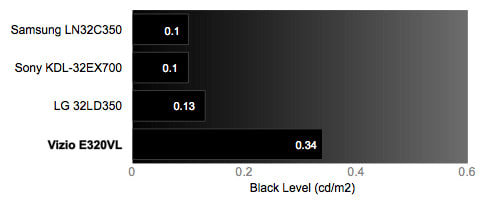
Peak Brightness
{{section_header}}{{section.name}}{{/section_header}}
The {{product.name}} is plenty bright. We measured it's peak output at 276.07 cd/m2. That compares quite favorably with most LCD televisions. Note in the chart below that it was much brighter than the Samsung LN32D450, a CCFL-backlit display. The LED backlighting on the {{product.name}} clearly has some advantages. More on how we test peak brightness.
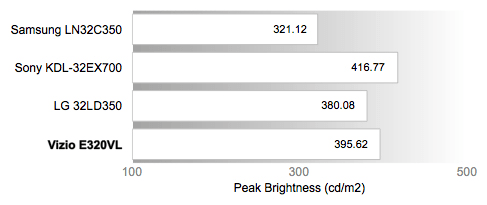
Contrast
{{section_header}}{{section.name}}{{/section_header}}
The {{product.name}} has a fantastic contrast ratio of 5521:1, thanks to its strong showing in the black level tests. It far outstripped the three TVs we pulled in for comparison. As we noted above, though, there was a lack of detail in the shadows that should be taken into consideration. Contrast ratio is only one aspect of a TV. More on how we test contrast.

Tunnel Contrast
{{section_header}}{{section.name}}{{/section_header}}
The {{product.name}} had little trouble maintaining a consistent black level, even if the area of screen displaying black varied. More on how we test tunnel contrast.
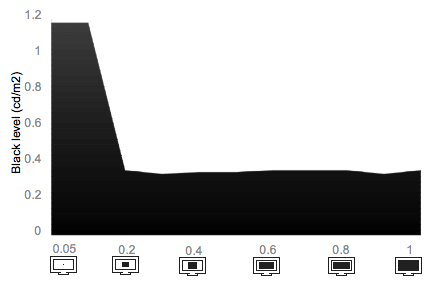
White Falloff
{{section_header}}{{section.name}}{{/section_header}}
As with the test above, the {{product.name}} also has no trouble maintaining a consistent peak brightness, even if the amount of white on the screen changes. More on how we test white falloff.
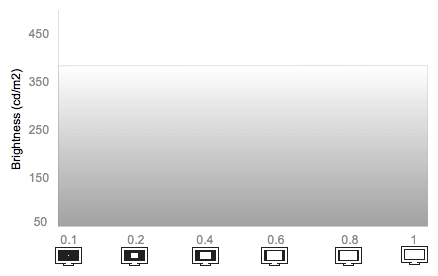
Uniformity
Greyscale Gamma
{{section_header}}{{section.name}}{{/section_header}}
The {{product.name}} had a mixed performance in our greyscale gamma testing, all told. As you can see in the chart below, the response curve is fairly smooth. There are no major hiccups, except in the left-most edge of the line, representing the shadow details. The little breaks in the line indicate areas where you might see some banding.
More importantly, though, is the slope of the curve in the shadow details. It's not a smooth and steady transition upwards like most of the line. The shadows experience a precipitous drop-off after a certain threshold. The TV is just not producing the range of tones that we want in the shadows.
Once the signal intensity hits the mids, though, the gamma curve levels out to exactly the slope that we want. An ideal slope is somewhere between 2.1 and 2.2. The {{product.name}}'s performance of 2.29 is very close to that. If only the shadows could have been better.
In order to be sure of our conclusions, we tried playing with a setting in the menu called Shadow Detail. We ran the tests with Shadow Detail at "0" and at "+2." There was no significant change. More on how we test greyscale gamma.
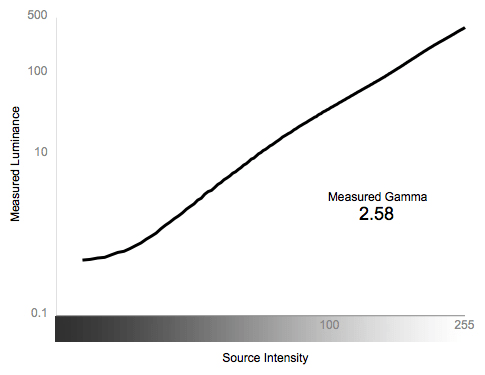
Color Temperature
{{section_header}}{{section.name}}{{/section_header}}
The {{product.name}} maintained a decent color temperature consistency up to a certain threshold, but as the signal started to get a little darker, it suddenly takes a warm nose dive. You can see for yourself in the chart below. The shadows will appear much more yellowish than the highlight or mids. More on how we test color temperature.

RGB Curves
{{section_header}}{{section.name}}{{/section_header}}
The {{product.name}} showed an uneven performance in the RGB color curve tests. As you can see, the reds responded much more brightly than the blues and greens. We suspected something like this might happen during the calibration process. We tried variations on the calibration and retested everything, but the original calibration proved the to have the best overall color performance. The blue channel is particularly saggy, indicating that the blues will have a lack of detail in the shadows and for much of the midtone range. More on how we test RGB curves.

The strips below are digital recreations of the data we collected from the RGB Color Curve test. You can see the {{product.name}}'s performance compared to three similar TVs and an ideal response curve.
Motion Performance
{{section_header}}{{section.name}}{{/section_header}}
The {{product.name}} did an adequate job in our motion performance tests. We see the usual artifacting here: some color trailing, some judder, some loss of fine detail. There's also the recurrence of a problem we've seen with many Samsungs this year that might be caused by laggy processing or a slow pixel refresh. Vertical lines can appear diagonal when they move across the screen. Of course, the visibility of the problem depends on a lot of factors, including the speed of the object.
Unlike more expensive Samsungs, the {{product.name}} does not have any processing features for motion smoothing. Typically, these work by inserting interpolated frames between the original frames. They're not perfect, but under the right conditions they can be very effective. More on how we test motion performance.
3:2 Pulldown & 24fps
{{section_header}}{{section.name}}{{/section_header}}
The {{product.name}} has no problems with native 24fps content, like you might get from a Blu-Ray movies. To get the best performance, be sure to locate the Film Mode settings in the menu and change it from Auto 2 to Auto 1. We couldn't completely eliminate the judder in slow camera pans, but it was a minor problem. More on how we test 3:2 pulldown and 24fps.
Resolution Scaling
{{section_header}}{{section.name}}{{/section_header}}
The {{product.name}} has a native resolution of 1366 x 768. Though TV manufacturers frequently label this as 720p, Samsung among them, there's a slight discrepancy here. In fact, the NTSC standard for 720p is a 1280 x 720 signal and that's what broadcasters are sending you through your cable box. The 1366 x 768 resolution is a holdover from computer, rather than TV, signals.
Were you to feed the {{product.name}} a 1366 x 768 signal from a computer, you should see perfectly crisp and clear lines. Unfortunately, this is a television review site and the product we're reviewing is a television that is meant to receive television signals. As a result, there were problems with every NTSC signal we sent. More on how we test resolution scaling.
480p
The 480p content lost 2% on all sides due to overscan and showed a lot of Moires in high contrast / high frequency patterns.
720p
There was no overscan with 720p signals, but we saw plenty of Moires. This should not happen in a "native" resolution signal. As we mentioned above, though, the 1280 x 720 signal is not really the {{product.name}}'s native resolution.
1080p
The 1080p signal had all the same Moire problems as the other signals did when trying to display high contrast / high frequency patterns.
Formats
{{section_header}}{{section.name}}{{/section_header}}
The {{product.name}} has a native resolution of 1366 x 768, which places it in the 720p category. Jump back a page to Resolution Scaling, however, and you'll see what happens when "almost 720p" isn't quite close enough. Nonetheless, the TV is fully capable of displaying all NTSC signals.
Viewing Angle
{{section_header}}{{section.name}}{{/section_header}}
The {{product.name}} has a terrible narrow viewing angle, just 35 degrees in total (17 degrees from center in either direction). As you can see, the Samsung LN32D450 did just as poorly, indicating a different backlight did not give the D4000 any advantage here. The Panasonic and Vizio we pulled in for comparison were far wider.

Reflectance
{{section_header}}{{section.name}}{{/section_header}}
The {{product.name}} did a decent job staving off reflections from ambient light. If hit with a very strong light, you'll see a small, diffuse glow on the screen, surrounded by four little rainbows. Those are created by the screen attempting to refract the light to minimize glare. If it's a softer light in the room or coming in from a less direct angle, you'll never see the rainbows. Fortunately, the minimal glare on the screen means a minimal impact on contrast ratio. This TV should be fine for a sunny room.
Video Processing
{{section_header}}{{section.name}}{{/section_header}}
The {{product.name}} has a number of video processing features. Though we find most of them detrimental to picture quality and recommend that you disable them, it's important to fiddle around in the menu and understand just what effect they have.
Calibration
{{section_header}}{{section.name}}{{/section_header}}
The {{product.name}} was a tricky one to calibrate as we tried to find the right blend of settings to maximize color performance. In the end, we did the best we could, but the results were not perfect. The TV demands that you make compromises. Give a little shadow detail, lose a little highlight detail. Gain some of the bright reds, lose some contrast ratio. You can calibrate anyway you want. Below is the chart that lays out our final choices.

All of our calibration is done in conjunction with the DisplayMate software.
](http://www.displaymate.com/)
Video Modes
{{section_header}}{{section.name}}{{/section_header}}
The {{product.name}} has a small selection of "one-touch" calibration modes if you don't feel up to fiddling with every little setting. Fortunately, you can choose one of these video modes and make those little tweaks later, should you feel adventurous.
Connectivity
{{section_header}}{{section.name}}{{/section_header}}
The {{product.name}} is certainly not loaded with a huge array of ports, but there's enough here to make it an option for a low-end home theater system and more than enough to make it a good choice for a bedroom or kitchen. For newer devices, there are four HDMI inputs. Older devices may have a harder time finding purchase, as there's just one shared component & composite AV input. It's not just any old input either; it's a bizarre proprietary jack that requires an adapter. Should you lose the one they provide... well, good luck.

The TV also has a USB port for connecting to USB mass storage devices for photo, video, and music playback. Beyond that, there are no multimedia ports here. In order to access Samsung's impressive line-up of streaming content, you have to step up to the D6000 series in the LED line of televisions.
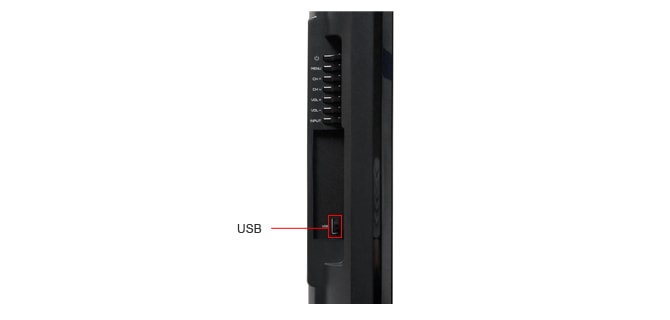

{{product.manufacturer_specs['Connectivity Tour Image 3']}}
Placement
{{section_header}}{{section.name}}{{/section_header}}
The {{product.name}}'s ports are arranged in an L-shape on the back of the TV. Those facing out to the side are easy to access and clearly labeled. You can also pivot the TV panel on its base to reach them a little easier. The ports that face downward, however, are rather tricky, especially the VGA port.
Audio Quality
{{section_header}}{{section.name}}{{/section_header}}
Mediocre audio quality is the norm on TVs, so anything that doesn't sound completely horrible is already coming out smelling like a rose. The {{product.name}} is not completely horrible. Neither is it a particularly rich listening experience. If you care about audio, you'll buy a separate surround sound system.
In the menu, you'll find several options to tweak the sound. There's a five-channel equalizer and several modes for one-touch changes to the tonality. We liked the "Standard" mode best. Of course, there's also a surround sound emulator that in no way approximates a surround sound system.
Menu Interface
{{section_header}}{{section.name}}{{/section_header}}
Samsung TVs have a great menu system, from the cheapest TVs up to the top. There's clearly been a lot of thought. In truth, all the major manufacturers probably put a lot of thought into their menu systems, but we really like what Samsung has done, which is an ability to scale up in TV's complexity without making the menu impossible to navigate. It's precisely where Sony has failed in 2011, with menus that break into submenus, then more submenus, then more submenus, like fractals.

You always know where you are in the Samsung menus. Everything is clearly labeled and simple to navigate. The remote control is intuitive and should you get lost, the Back and Exit buttons are close at hand.

Instruction Manual
{{section_header}}{{section.name}}{{/section_header}}
Unfortunately, for as good as their menus are, the clarity and accessibility of Samsung's instruction manuals has gotten worse. The manuals are no longer unique to each series of TV. It's not as bad as Sony (sorry to pick on Sony again, but they really have gotten worse this year). The TV has an e-manual built into it, which you can also download as a PDF. They're fairly easy to search through, but because they cover multiple series of TVs, there's no discussion of the external features of the TV, like buttons and ports. There's also a number of features in the manual that have little clarifications that it's only available on such-and-such a model. Overall, it's passable but not great.

A manual for so many TV models, they have to be further categorized by type.
Local Media Playback
{{section_header}}{{section.name}}{{/section_header}}
The {{product.name}} has a single USB port for connecting to USB mass storage devices. It supports the playback of photos, video, and music files. The process is quite simple. Plug in your device and the TV asks if you want to connect. Select yes, then choose the media type.

There are plenty of options to customize the playback experience, including the slideshows with music and playlists for music and movies. These are all fairly common on TVs over a certain price point, but we really enjoyed the Samsung interface, which looked cleaner and more approachable than other manufacturer's menus.
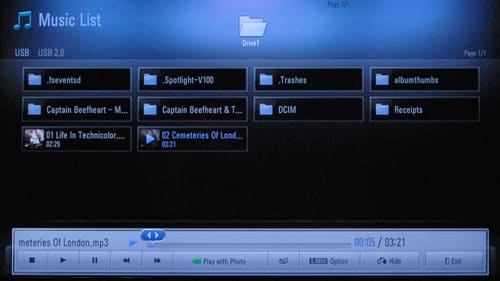
Power Consumption
{{section_header}}{{section.name}}{{/section_header}}
The {{product.name}} requires virtually no power to run – only 35 watts if you the lower the backlight to our recommended minimum. Note, however, that when we perform our tests the backlight is turned up to the maximum setting. Even then, it only took 42.6 watts, on average.
As you can see in the chart below, the TV requires less power than all the TVs we pulled in for comparison.
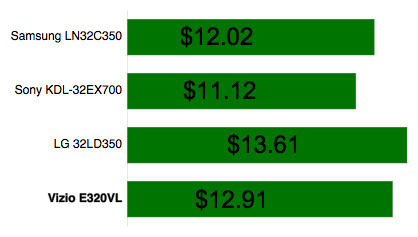
Value Comparison
{{section_header}}{{section.name}}{{/section_header}}
The Samsung LN32D450 and {{product.name}} are both LCD televisions – don't let the terminology get in the way. The difference is that the Samsung with "UN" in their name use LED backlighting, while those with an "LN" use the older CCFL backlighting. That's the only significant difference. So what does LED backlighting get you? In general, it means a thinner frame and increased energy efficiency. Sometimes you get features like local dimming, but not on the UNxxD4000 series. Not general to CCFL vs. LED match ups, but particular to the D450 vs. the D4000, the D4000 had a much wider contrast ratio. However, the color response and viewing angle were similar, and both poor. Neither have any super special features like internet connectivity or 3D display, and both are limited to a 720p resolution.
Blacks & Whites
{{section_header}}{{section.name}}{{/section_header}}
The {{product.name}} produced a very deep black level for an LCD television, far deeper than the Samsung LN32D450, which was good in its own right. The {{product.name}} was also brighter. That all added up to a much wider contrast ratio.

Color Accuracy
{{section_header}}{{section.name}}{{/section_header}}
The {{product.name}} and Samsung LN32D450 produced similar color performances, almost point for point. That indicates that perhaps the TVs share a common processor. Overall, the performance was characterized by a lack of detail in the shadows and midtones for the blue, and to a lesser extent in the green channel. The color temperatures of each TV also tended to warm as the signal intensity decreased.
Motion
{{section_header}}{{section.name}}{{/section_header}}
The {{product.name}} and the Samsung LN32D450 were remarkably similar in the motion performance tests. Both showed a fair amount of color trailing and judder, as well as the "diagonalization" of vertical lines.
Viewing Effects
{{section_header}}{{section.name}}{{/section_header}}
Both TVs have a terribly narrow viewing angle.
Connectivity
{{section_header}}{{section.name}}{{/section_header}}
The {{product.name}} offers two additional HDMI ports, as well as an extra composite and component AV input.
Value Comparison
{{section_header}}{{section.name}}{{/section_header}}
The Panasonic TC-L32X30 is a LCD 720p TV, like the {{product.name}}, but Panasonic throws in the option for streaming internet content for roughly the same price as the sans-internet Samsung. (Panasonic also includes an iPod dock, should you consider it useful). We liked the Panasonic's color performance better, but the IPS technology that was meant to help viewing angle ends up doing more damage to the overall enjoyment and versatility of the TV.
Blacks & Whites
{{section_header}}{{section.name}}{{/section_header}}
The {{product.name}} has a much, much deeper black level, and though the Panasonic X30 produced a significantly brighter white, the Samsung's contrast ratio won the day.

Color Accuracy
{{section_header}}{{section.name}}{{/section_header}}
The {{product.name}}'s color performance was largely uneven, with saggy response curves and an inconsistent color temperature. The Panasonic's performance was more tempered, marred only by some lack of detail in the highlights.
Motion
{{section_header}}{{section.name}}{{/section_header}}
The {{product.name}} and Panasonic X30 showed similar problems in the motion performance tests: lost of detail, judders, some color trailing, and skewed vertical lines.
Viewing Effects
{{section_header}}{{section.name}}{{/section_header}}
The Panasonic TC-L32X0 had a far wider viewing angle than the average LCD television, thanks to its IPS (In-Plane Switching) pixel technology. It allows for a much wider viewing angle than the older LCD displays. However, it has the significant downside of a limited up & down viewing angle. In other words, if you're not sitting perfectly level with the TV, the viewing angle is terrible.
Connectivity
{{section_header}}{{section.name}}{{/section_header}}
The {{product.name}} offers one additional HDMI port, an additional composite AV input, an SD card slot, and ethernet to connect to streaming content.
Other Comparisons
{{section_header}}{{section.name}}{{/section_header}}
The Panasonic X30 offers access to Netflix, Amazon on Demand, Pandora, and a host of other streaming content services. There's also DLNA support for a local home theater network.
Value Comparison
{{section_header}}{{section.name}}{{/section_header}}
The Vizio E321VL is not the prettiest TV, nor does it have the best menu design, but a low price of just $349 (MSRP) can make you overlook some of those imperfections. Like the {{product.name}}, it's a 720P LCD, though it uses the older CCFL backlighting instead of LEDs. This is not a performance-oriented TV, even less so than the {{product.name}}. However, you can do worse in you're shopping for bargains.
Blacks & Whites
{{section_header}}{{section.name}}{{/section_header}}
The {{product.name}}'s black level was far, far deeper than the Vizio's and the peak whites were just as bright. There was no contest here.

Color Accuracy
{{section_header}}{{section.name}}{{/section_header}}
The Vizio E321VL's best showing was in the color tests, which kept pace or outperformed the {{product.name}}.
Motion
{{section_header}}{{section.name}}{{/section_header}}
The Vizio E321VL had a hard time in our motion tests, producing a lot more artifacts and judder.
Viewing Effects
{{section_header}}{{section.name}}{{/section_header}}
The {{product.name}} had a particularly narrow viewing angle, so it's not surprising that it was beaten by the Vizio E321VL.
Connectivity
{{section_header}}{{section.name}}{{/section_header}}
The {{product.name}} offers two more HDMI ports than the Vizio E321VL. Other than that, they're quite similar.
Conclusion
The {{product.name}} ($529 MSRP) is a decent television, but you can do better. Yes, it's a very attractive TV. The LED backlighting has allowed the TV's frame to be thinner than a TV using the older CCFL backlighting. Beyond simple aesthetics, the {{product.model}} produced deep black levels and an impressive contrast ratio.
The negative points may outweigh the positives, though. First and foremost, the resolution is limited to 720p, or 1366 x 768, to be precise. This meant that all the standard TV resolutions (480p, 720, 1080i, and 1080p) all came out a little fuzzy when trying to display fine detail like text, fabric patterns, or tight stripes. You can sidestep this problem entirely by choosing the Samsung LNxxD550 series (reviewed here), which have a full 1080p resolution. They feature CCFL rather than LED backlighting, but we liked them just fine.
Overall, the {{product.name}} could be a fine choice for the bedroom or kitchen TV, but it's just not equipped to be your prime time player.
Model Series Comparison
{{section_header}}{{section.name}}{{/section_header}}
The UNxxD4000 series is limited to just two small models, a 19-inch and a 32-inch. Both are 720p models with LED backlighting. It's clearly an entry level series designed for the bedroom or someplace other than the entertainment hub of your household.
Photo Gallery
{{photo_gallery "Front Tour Image", "Back Tour Image", "Sides Tour Image", "Stand Photo", "Controls Photo", "Remote Control Photo", "Connectivity Tour Image 1", "Connectivity Tour Image 2", "Connectivity Extra Photo", "Menu Main Photo", "Menu 2 Photo", "Internet Features 1 Photo", "Internet Features 2 Photo", "Internet Features 3 Photo", "Local Media Playback 1 Photo", "Local Media Playback 2 Photo"}}
Ratings & Specs
{{manufacturer_specs_table}}
Meet the tester
David Kender oversees content at Reviewed as the Editor in Chief. He served as managing editor and editor in chief of Reviewed's ancestor, CamcorderInfo.com, helping to grow the company from a tiny staff to one of the most influential online review resources. In his time at Reviewed, David has helped to launch over 100 product categories and written too many articles to count.
Checking our work.
Our team is here to help you buy the best stuff and love what you own. Our writers, editors, and experts obsess over the products we cover to make sure you're confident and satisfied. Have a different opinion about something we recommend? Email us and we'll compare notes.
Shoot us an email